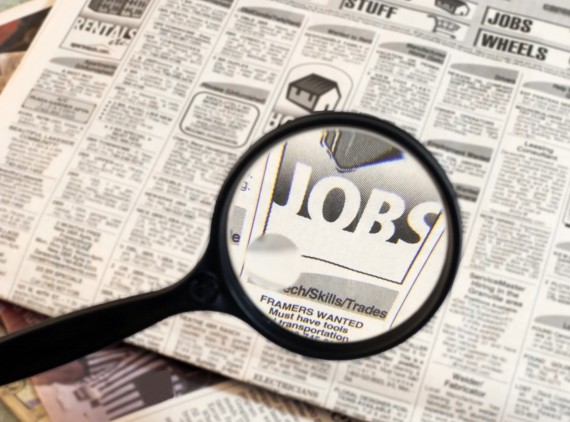Jobs Growth Bounces Back From Hurricane-Related Losses
The Jobs Market bounces back in October, but the numbers are far from impressive.
The September Jobs Report saw job growth fall into negative territory thanks mostly to the twin hits of Hurricanes Harvey and Irma in Texas and Florida respectively. At the time, most experts noted that it was likely that the storms, which disrupted millions of lives and cost what is likely to be billions of dollars in losses, was likely the main reason for the disappointing report, and that we should expect a bounce back to something approaching normal for October and the months going forward. As it turned out, we saw a strong but not overwhelming increase in jobs created, but not quite as large as some projections were expecting:
Total nonfarm payroll employment rose by 261,000 in October, and the unemployment ratev edged down to 4.1 percent, the U.S. Bureau of Labor Statistics reported today. Employment in food services and drinking places increased sharply, mostly offsetting a decline in September that largely reflected the impact of Hurricanes Irma and Harvey. In October, job gains also occurred in professional and business services, manufacturing, and health care.
The unemployment rate edged down by 0.1 percentage point to 4.1 percent in October, and the number of unemployed persons decreased by 281,000 to 6.5 million. Since January, the unemployment rate has declined by 0.7 percentage point, and the number of unemployed persons has decreased by 1.1 million. (See table A-1.)
Among the major worker groups, the unemployment rates for adult women (3.6 percent) and Whites (3.5 percent) declined in October. The jobless rates for adult men (3.8 percent), teenagers (13.7 percent), Blacks (7.5 percent), Asians (3.1 percent), and Hispanics (4.8 percent) showed little change. (See tables A-1, A-2, and A-3.)
In October, the number of long-term unemployed (those jobless for 27 weeks or more) was little changed at 1.6 million and accounted for 24.8 percent of the unemployed. (See table A-12.)
The labor force participation rate decreased by 0.4 percentage point to 62.7 percent in October but has shown little movement on net over the past 12 months. The employment-population ratio declined by 0.2 percentage point over the month to 60.2 percent, after increasing by 0.3 percentage point in September. The employment-population ratio is up by 0.5 percentage point over the year. (See table A-1.)
(…)
Total nonfarm payroll employment increased by 261,000 in October, after changing little in September (+18,000). Employment in food services and drinking places increased sharplyover the month, mostly offsetting a decline in September that largely reflected the impact of Hurricanes Irma and Harvey. In October, employment also increased in professional and business services, manufacturing, and health care. (See table B-1.)
Employment in food services and drinking places rose sharply in October (+89,000), following a decrease of 98,000 in September when many workers were off payrolls due to the hurricanes.
Professional and business services added 50,000 jobs in October, about in line with its average monthly gain over the prior 12 months.
Manufacturing employment rose by 24,000 in October, with job gains in computer and electronic products (+5,000) and chemicals (+4,000). Employment in fabricated metals continued to trend up (+4,000). Manufacturing has added 156,000 jobs since a recent employment low in November 2016.
Health care added 22,000 jobs in October. Employment in ambulatory health care services continued to trend up over the month (+16,000). Health care has added an average of 24,000 jobs per month thus far in 2017, compared with an average gain of 32,000 per
month in 2016.Employment in other major industries, including mining, construction, wholesale trade, retail trade, transportation and warehousing, information, financial activities, and government, changed little in October.
In addition to the above numbers, the Bureau of Labor Statistics reported that total nonfarm payroll employment for August, which had disappointed many due to the fact that they fell below estimates, was revised upward from +169,000 to +208,000, while the change from September was revised from -33,000 to +18,000, for a net upward adjustment of +90,000 jobs. This makes for net downward revisions for both months at -38,000. Combined with this month’s numbers puts the average for the past three months at +162,333 net jobs created, a better number than we saw for the previous three-month period but still not entirely impressive. For the year, we’ve seen a total of 1,730,000 new jobs created since January for a monthly average of +173,000 jobs per month, which is better than last month’s average but still not entirely impressive due in no small part to the downward influence of the weak September numbers. During his campaign for President, Donald Trump promised to create 25,000,000 jobs during his Presidency. That would require the creation of 3,125,000 per year over an eight-year term for an average of 261,000 new jobs per month. Over a four-year term that would require 6,250,000 per year, for an average of 521,000 new jobs per month. At the current three-month average, it would take 12 years to get to Trump’s goal. At the current average for the year-to-date, it would also take more than 12 years. And that assumes no recessions in the intervening period.
Looking deeper into the report, the news is mixed at best. The average workweek was unchanged across the board, but average hourly earnings increased by 12 cents to $26.55. This means the year-over-year increase in wages stands at 74 cents or roughly 2.9%. Meanwhile, the labor force participation rate dropped four-tenths of one percent to 62.7%, while the employment-population ratio fell two-tenths to 60.2%. Long-term unemployment, meanwhile, stands at 7.9% Additionally, the top-line unemployment number fell one-tenth of one percent to 4.1%. This suggests that the jobs market is roughly the same shape that it has been for the balance of the year, but it also suggests that we’re approaching something approximating what economists consider full employment, meaning that job growth going forward could be sluggish absent circumstances that spur employers to increase hiring significantly. The relatively strong bounce back from the storm-related numbers in September it is an indication that the Federal Reserve Board is likely to go forward with its planned rate increase at its upcoming December meeting.
On the whole, this number is a relatively strong bounce back from the disappointing numbers in September, but hardly anything to write home about. The concerning numbers, of course, are related to wage growth, which remains low and shows little signs of increasing significantly in the future. If anything, the fact that we are slowly approaching the point where employment has reached a point where it’s unlikely that we’ll see real jobs growth beyond the current levels going forward, the fact that wages aren’t growing either is a sign that employers sense that they don’t need to increase wages to either ensure that current employees don’t wander off into a higher paying job or to attract new job applicants. As long as that continues, then the economy and the jobs market will likely stay stuck in the same good-but-not-great cycle that it has been for some time now.





It will all be better once the 1%ers get their massive gift from Don-the-Con…then they will start hiring like crazy because of all the extra money in their pockets that they don’t know what to do with.
@Daryl’s other brother Darryl:
And we thank you.